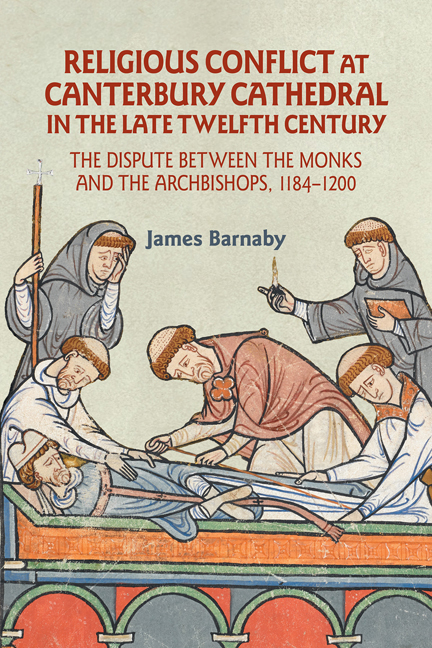 Religious Conflict at Canterbury Cathedral in the Late Twelfth Century
Religious Conflict at Canterbury Cathedral in the Late Twelfth Century Book contents
- Frontmatter
- Dedication
- Contents
- List of Maps
- Acknowledgements
- List of Abbreviations
- Introduction
- 1 The Canterbury Dispute in the Sources
- 2 Baldwin's Grand Plan (1184–November 1186)
- 3 To Rome (November 1186–July 1187)
- 4 The Hackington Dispute (August 1187–September 1189)
- 5 A New King, A Crusading Archbishop, and A Temporary Peace (September 1189–August 1191)
- 6 A New Primate (1191–3)
- 7 The Dispute Renewed (1193–1200)
- 8 After Lambeth: The Dispute in Later Centuries
- Conclusion
- Appendices
- Timeline
- Select Bibliography
- Index
- Other volumes in Studies in the History of Medieval Religion
3 - To Rome (November 1186–July 1187)
Published online by Cambridge University Press: 09 May 2024
- Frontmatter
- Dedication
- Contents
- List of Maps
- Acknowledgements
- List of Abbreviations
- Introduction
- 1 The Canterbury Dispute in the Sources
- 2 Baldwin's Grand Plan (1184–November 1186)
- 3 To Rome (November 1186–July 1187)
- 4 The Hackington Dispute (August 1187–September 1189)
- 5 A New King, A Crusading Archbishop, and A Temporary Peace (September 1189–August 1191)
- 6 A New Primate (1191–3)
- 7 The Dispute Renewed (1193–1200)
- 8 After Lambeth: The Dispute in Later Centuries
- Conclusion
- Appendices
- Timeline
- Select Bibliography
- Index
- Other volumes in Studies in the History of Medieval Religion
Summary
On 25 November 1186, Becket appeared in a vision to Brother Andrew John. In this vision (recorded in detail by Gervase) the martyr bade the monk rise from his bed and follow him into the tower next to the choir. There, Andrew John was shown a large Catherine wheel hurling blue flame. Andrew John asked the name of the man who was leading him. Becket replied, ‘I am Thomas your archbishop, who for this church and in this church suffered martyrdom.’ Withdrawing from the wheel, Andrew John saw Baldwin approaching the phenomenon. Taking three swords and leaning on each in turn to test their strength, the archbishop summoned Prior Honorius. On his arrival, Baldwin said to him ‘I wish to destroy this new work [the recent renovations to the cathedral in honour of Becket], and for this purpose I have made this wheel, but without you I cannot move it.’ The dismayed prior obeyed the archbishop and summoned the other monks to help him. Andrew John begged Becket to intervene. The saint drew his sword, inscribed with letters of gold, and suddenly the archbishop vanished. Becket gave his sword to Andrew John, showing him the inscription ‘Gladius beati Petri apostoli’. He ordered Andrew John to present the sword to Honorius who should use it to destroy the Catherine wheel. Reluctant to disturb the prior, Andrew John had the vision three times before he finally spoke of it. According to Gervase, the Catherine wheel was interpreted by Honorius as symbolic of the new church that Baldwin planned to build as well as a representation of the destruction of the convent if Baldwin's plan was to proceed. The prior interpreted the sword as representing the process of appeal to Rome. Just as St Peter had attempted to protect Christ with his sword, so would the successors of Peter protect the monks with their spiritual weapons.
According to the vision, it was Baldwin's desire to destroy the cathedral convent, and the blessed martyr's wish that the monks resist with all their strength. The depiction of the Hackington church as a Catherine wheel is significant, since the wheel was a device of torture, or execution, to which the victim would be tied so that their bones might be shattered. This was the method by which Emperor Maxentius had hoped to execute St Catherine.
- Type
- Chapter
- Information
- Religious Conflict at Canterbury Cathedral in the Late Twelfth CenturyThe Dispute between the Monks and the Archbishops, 1184-1200, pp. 57 - 84Publisher: Boydell & BrewerPrint publication year: 2024
